As of… now! we’re allowed to officially tell you what many of you already suspected – that there was going to be a further reveal to the Shimano XTR 11speed story. Already well established in the pro peloton and also used successfully for the last couple of years on the cyclocross circuit, Shimano’s Di2 electric shifting system has been incorporated into Shimano’s flagship groupset. With development taking place over the last three years as part of Shimano’s 20,000km pre-launch testing of XTR, we’re expecting nothing short of a spectacular groupset, and initial impressions are very favourable.
Here’s the zoom-splash video!
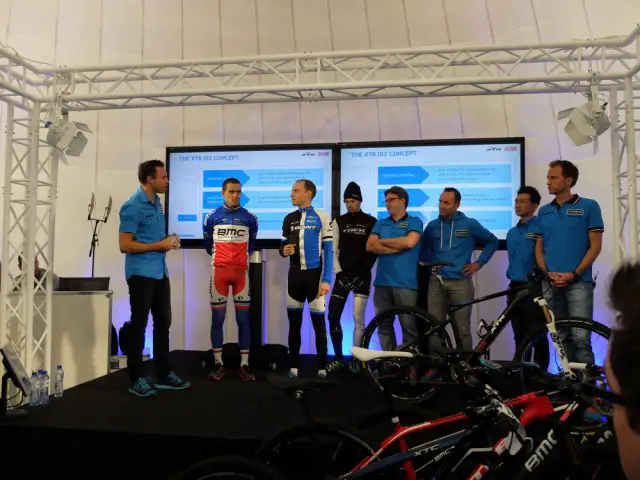
Shimano’s confidence in the group is impressive – as it has equipped some of its top racers (like Julien Absalon and Dan McConnell) with the new groupset and, with less than a week of testing it on their bikes they’re all set to race this Sunday’s UCI World Cup on it.
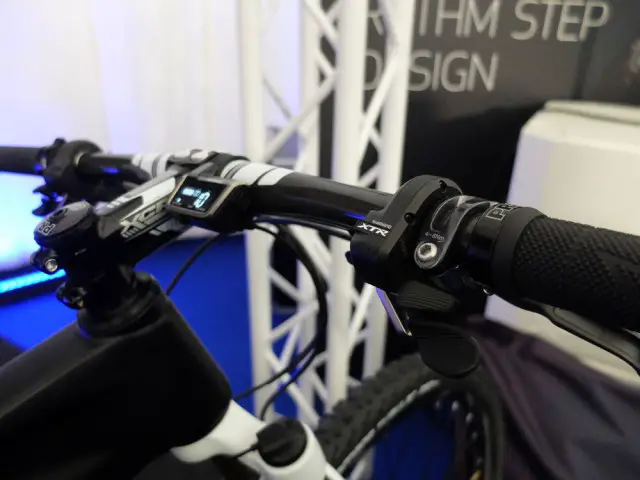
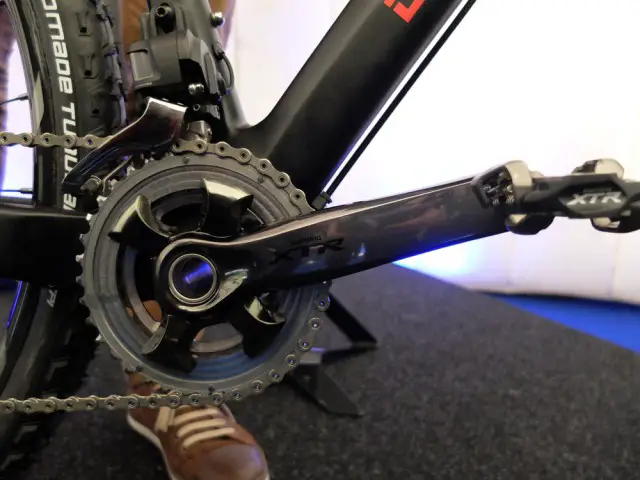

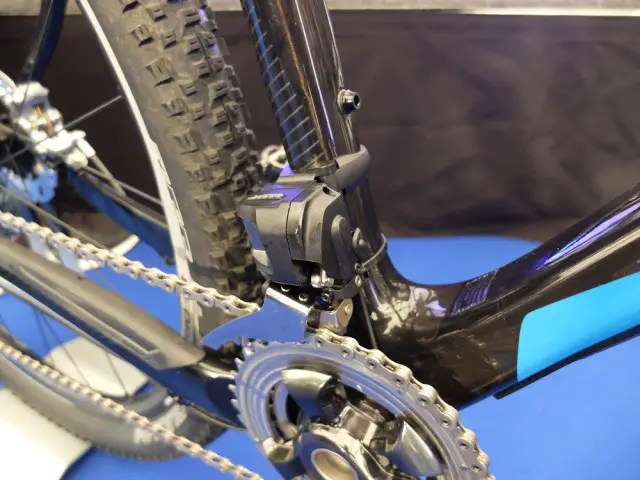
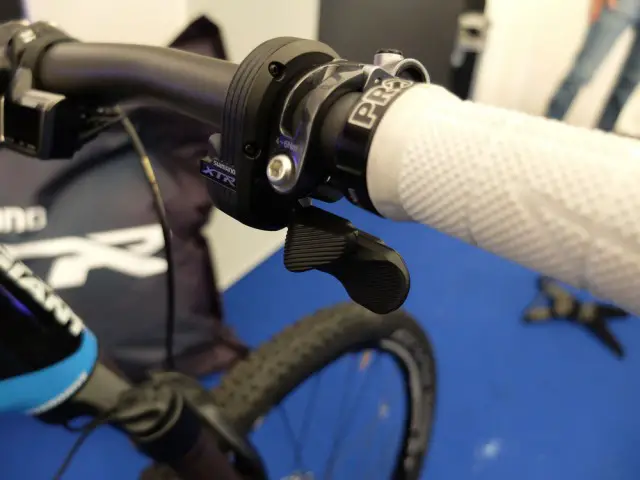
Di2 is already in its second incarnation on Shimano’s Dura Ace groupset, having been slimmed down a lot so that the motors are a lot less noticeable than before. This continues over to XTR, where only a couple of bulges on the front and rear mech suggest the electric nature of the gearing. Shifting is controlled by wires (in case you were expecting something wireless like SRAM’s recent road groupset has in development) and there are a pair of neat shifters on the handlebars, along with a digital screen that indicates the gear selected, the battery level and which mode the system is in. There’s also scope to integrate Fox’s iCD remote shock lockout system too (it’s not the first time the two companies have worked together, Shimano helped develop the 15mm thru-axle used in Fox’ forks and provides batteries and other tech for Fox’ electric lockout systems)
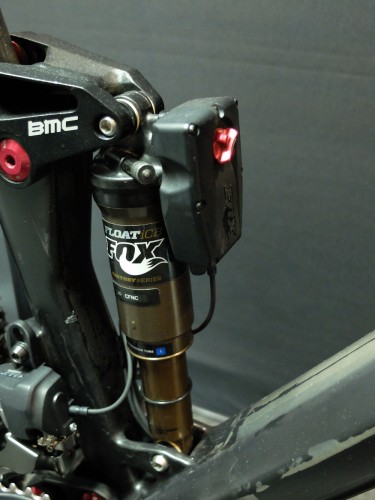
In its simplest mode, there’s a pair of up/down buttons under each thumb, with the left side doing front shifting and the right pair doing rear shifting (assuming you’re running two or three rings up front. Running 1×11 will only need a single shifter pod). Being an electric system, though, the buttons are just switches and can be re-programmed to suit – so if you wanted a more ‘paddle shift’ approach to gears, that can easily be done by the (PC only) control box that hopefully your local shop will buy. This box of tricks can also do a lot more, setting up the special modes…
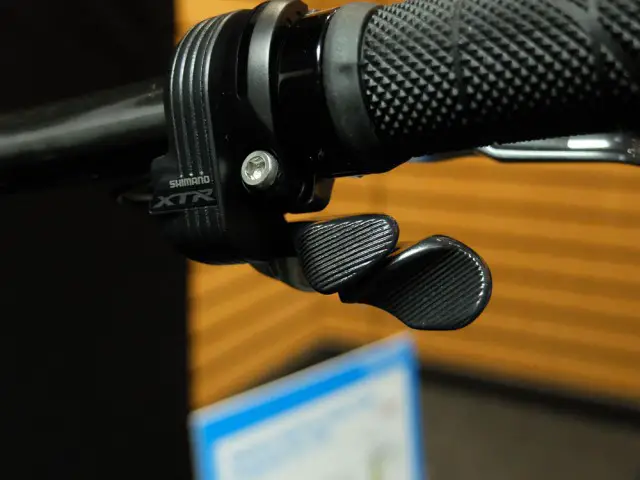
Things get more interesting though when you go into one of two special modes. Here, you can get the gears to shift sequentially front and rear – which needs only a single shift unit, even if you’re running 3×11. The sequential gears can be run as a true sequential gear system, shifting at the front and back to choose the smoothest way through the gears, or it can additionally be set up with two different profiles (that you can select while riding). You could, for example, have a profile that keeps you in the big ring for the whole of the rear block, keeping the chain tight and only bailing out into the inner ring when you’ve used all those gears up. Or you could have a ‘first lap of the race’ setting where it only keeps you in the big ring, then you select regular mode for the rest of the race. It all has great potential.
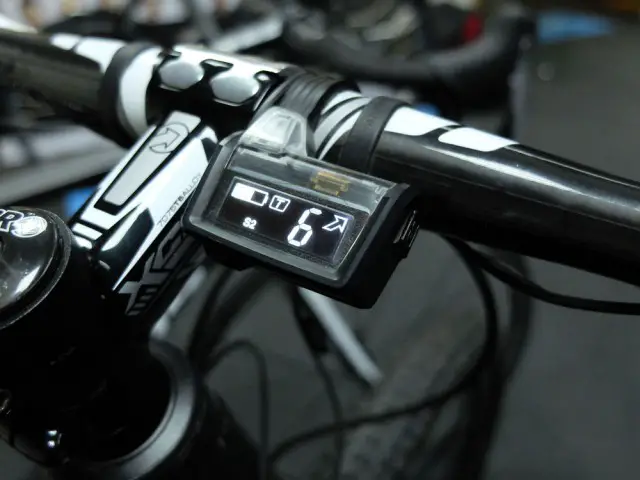
In terms of reliability, we’ve seen road Di2 used extensively in the worst conditions in cyclocross racing for a couple of years. Shimano have then done years of additional testing to make sure it withstands the rigours of off-road bumping around and filthy conditions. There are still some potential vulnerabilities in the flexible wires used to connect the shifters and mechs. While Shimano expects that all OEM speccing of the system will be on bikes with neat, internal routing, the aftermarket is a different matter and we think we’ll still see a few bikes with external cables taped on to the outside of frame tubes. There’s also the possibility for a wire to get hooked on a branch, or sliced by a suspension pivot – or for a mech to get smashed by a rock (the motor safely disengages from the mech if, say, a stick gets caught in the wheel) – but these are dangers with any system – although the price of failure is higher with a £400 rear mech. It’ll be interesting to see where manufacturers hide the battery, as the internal battery will only fit inside the seatpost (as it does on road bikes) if you’re not running a dropper post. Inside the fork steerer tube is one suggestion we might see, otherwise an external bottle boss, chainstay or BB mount will work.
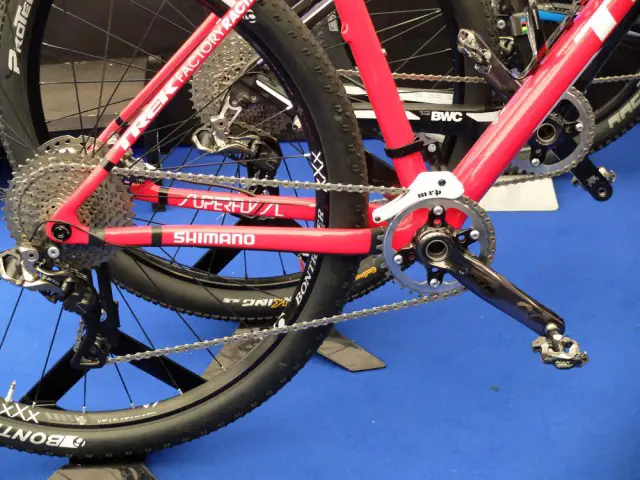
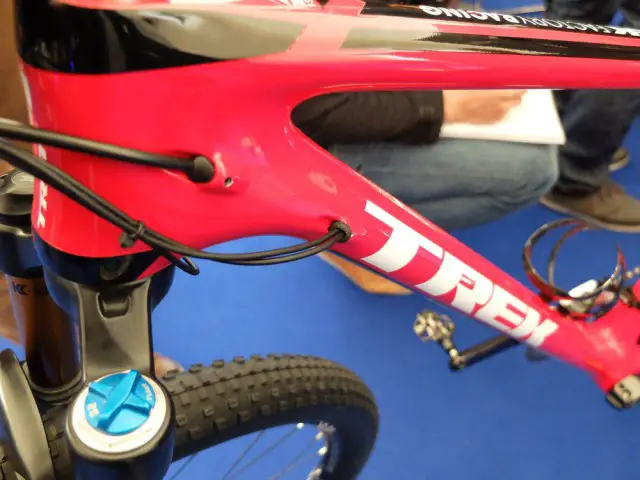
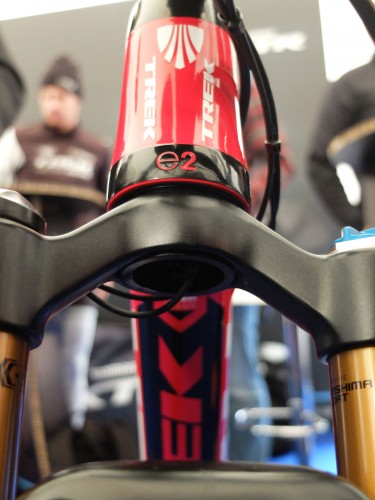
Overall, though, it looks like Shimano has put a lot of work into making sure that XTR is as durable and reliable as possible. The shifting motors are reasonably unobtrusive and the ‘Firebolt’ shift buttons are small and neat. The shift action has more throw than a road Di2 switch (though way less than a mechanical shifter) and a more positive click to make it discernible over the bumping around off road. There are two clicks in either direction, to allow for quick rear shifts, plus a ‘push and hold’ option. The front mech will auto-trim (and comes in either a double or triple setup) and the motor is said to be 50% stronger than Dura Ace.
Chipps is in Albstadt, Germany right now at the World Cup XC race, where it’ll be campaigned in anger this weekend by Shimano’s top sponsored riders – and he’ll also be getting an exclusive ride on the new XTR Di2 groupset, so stay tuned for his first impressions. We expect to see production samples start to come through around New Year 2015.
UK Prices:
Rear Mech: £429.99
Front Mech: £269.99
Left and right shifters £149.99 each
Batteries: Internal £99.99. External £49.99
PCE1 (optional cable/programming interface): £179.99
Junction boxes and cables will be another £100 (approx) a bike.
WEIGHT INFORMATION
Front derailleur (FD-M9070 D-type) | 115 grams
Rear derailleur (RD-M9050-GS) | 289 grams
System display (SC-M9050) | 30 grams
Shift switch (SW-M9050) | 64 grams
In case that’s not enough enthusiasm, here’s the official press release.
SHIMANO ELECTRIFIES XTR
Shimano is pleased to announce the launch of the first electronic groupset for mountain biking, XTR Di2 (M9050). This development is the result of a very extensive testing program and is the moment many mountain bikers have long been waiting for. XTR Di2 comes in addition to the previously announced XTR M9000 mechanical groupset. The Di2 platform offers a number of advantages over a regular mechanical system including faster, more accurate and more powerful shifting which remains consistent in all riding conditions. Shifting requires minimal effort with a simple press of a button. XTR Di2 also brings a new programmable shifting layout called Synchro Shift. XTR Di2 offers a clean appearance on the bike and low maintenance thanks to the use of electrical wires.
Electronic shifting is not controlled by a regular mechanical shifter; it is controlled by a new electronic switch. Working with Shimano’s test riders and professional racers, Shimano engineers designed and tested many varieties of switches before the perfect solution was found. The result is Firebolt; an electronic shift switch that provides a natural feel, feedback and ergonomics. XTR’s easy to reach, compact shift switches offer a short stroke with tactile feedback.
Intuitive operation
One of the main advantages of electronic shifting is the programmability of the system. With new XTR Di2 it is possible to have the best shifting setup for every individual riding style. XTR Di2 works on the same E-tube platform as Shimano’s current road Di2 groupsets. The E-tube platform offers full programmability of the groupset and transmits interactive signals and power supply to each individual part by ‘plug & play’ connection. E-tube makes it possible to customise your shifting system by changing the function of the shift buttons. For example, it is possible to change the control of the front derailleur to the right switch and/or the control of your rear derailleur to the left switch. Multi shifting is also possible with XTR Di2 and is fully programmable. Multi shift can be engaged by pressing and holding the shift switch. Not only is the speed of the shift customisable but also the number of shifts, whether you want to shift up to a maximum of two sprockets with a single hold, or all the way through the cassette. Working with E-Tube electric wires also means no rust and no cable stretch while ensuring low maintenance and consistent shifting compared to a traditional mechanical cable-operated system.
One of the most unique features of XTR Di2 is the new Synchro Shift option. XTR Di2 has undergone over 20,000 test kilometers. This extensive test period allowed Shimano engineers to closely analyse the most used gears to be effective. With Synchro Shift enabled, it is possible to control both derailleurs with just one shifter. The front derailleur reads the position of the rear derailleur and automatically operates the front shift to position the gears in the most efficient gear and best chain line so the rider never has to worry about front shifting and correction shifts again. Synchro Shift is best explained in this video and improves efficiency of shifting and riding.
Shimano have used all the data from test riding to produce two pre-set shifting maps. E-tube allows the rider to change these pre-sets and create their own preferred shifting map. While riding it is possible to change between the programmed shifting maps or change back to manual mode. XTR Di2 provides fast and accurate shifting with less effort compared to mechanical systems.
Powerful shifting
Responsible for these shifts are the XTR Di2 derailleurs. These derailleurs deliver powerful, accurate and consistent shifting. The Di2 front derailleur is twice as powerful as the current M980 front derailleur and provides reliable, fast and smooth gear changes, even under heavy load. Shifting becomes effortless regardless of the terrain with a simple the push of a button. The rear derailleur is upgraded with new Shadow RD+ technology for Di2. Besides the regular on and off switch it is now also possible to externally adjust the spring tension of the rear derailleur with an Allen key (see video). The derailleurs react instantly to rider input and take up an accurate position in every gear combination using the front derailleur auto-trimming function. The electric wires guarantee stable and consistent performance.
Clean appearance and system expansion
The ‘brain’ of the XTR Di2 system is the digital display. This display indicates the battery level, gear position, shift mode (manual or Synchro) and the suspension mode. Using a button on the display it is also possible to change the shift mode to either manual or choose one of the two Synchro Shift maps, even while riding. The display also functions as a charging port, connection to the E-tube software (for personal settings) and includes 3 E-tube ports. Thanks to the E-tube platform, mountain bikes get a cleaner appearance. Electronic wires are easy to hide inside the frame and it is possible to integrate the Fox suspension system which minimises the visible cables on the bike and handlebars.
XTR Di2 M9050 uses the same batteries as its road equivalent. The external SM-BTR1 battery and the internal SM-BTR2 battery.
Comments (13)
Leave Reply
Post Comment


How much!?
Let’s hope the tech works it’s way down to the lower ranges sooner rather than later
I’ve always though that electronic shifting offered greater benefits to mtbs over road bikes, simply because of the conditions that mtbs get ridden in. No more shift cables full of mud!
Now listen, am I missing something here? Really, what is the point of electric shifting gears? Mechanical gears work fine and have done for years as do 3×8 or 3×9 – do we really all need 10 and 11 gears? Nope. Do we need electric gears? Nope. Its all marketing, just trying to get you to think that your existing kit is useless and you HAVE to have the latest stuff.
Just get out and ride more, shaving a stone off your weight will make you a faster rider not shaving a few oz from your bike or thinking you can go faster with electric gears.
And before anyone calls me a luddite, I ride tubeless.
rant complete
Got a road bike with Di2 group set at Easter, it’s a sea change. Quicker shifts, no sloppiness or cable stretch and smoother up and down the block and an an end to front mech rub (the curse of the double chain set IMO). 800km and battery still showing as fully charged and only missed gears when I inadvertently cocked up the indexing.
Bring on affordable electronic shifting for MTB – while XTR is out of most of our leagues history shows that what is XTR now will be SLX in a few years time – I for one can’t wait for the trickle down to XT or SLX.
Is it just me or is this starting to go too far. Electric shifting that does it better than the rider and can be programmed in advanced. It almost seems like cheating, surely riding and controlling a pedal bike should be done, in full, by the rider? We’ll end up with electric smart shifting, electric auto adjusting suspension and all the rider will be doing is pedalling and pointing the bike in roughly the right direction. I think there is a place for this sort of tech but I would hate to see electric everything becoming the standard.
In short believe that all the controls and power of the bike should be mechanical with power/control coming from the rider using skill and fitness.
This isn’t a rant, just a personal opinion on what may become a controversial subject.
I like the idea of saving weight by using the electric gear system, its brilliant. I intend to upgrade straight away and will connect a leisure battery on a rear carrier so that I can power my laptop and video gear. I could also power my phone charger and satnav not to mention my heated gloves and boot liners.
Electric shift on road ok, but on MTB where you can easily damage a rear mech… could prove VERY expensive!
Loving all these rants from the fully rigid, v’brake single speed crowd above…..
Nothing for you here, move along.
Whats wrong with v-brakes – you mean there’s something else? 😉
New ideas are great with multi ring programmable being a definite improvement. My preference on mtb is simpler but quantity kit to spend more time riding rather than tech tweaking as I’m generally time poor.
Looking at the Di2 rear mech, it’s a pretty chunky thing. It’s already inboard, due to the Shadow system and it sandwiches the Shadow dropout now. Add the crash protection that saves the motor and I reckon they’ll be pretty bomber strong.
As for the progress, how are you getting on with your friction shifting gears? Surely indexing is also cheating? 🙂
Tune in for my riding thoughts soon!
Stu N – “an end to front mech rub (the curse of the double chain set IMO)” – (only since rapidfire…)
Can anyone on here remember thumbshifters and particularly the non-indexed left hand front mech shift…… front mech rub was never really a big issue before rapidfire both ends.
I used to like the simplicity of thumbies but I got used to and love rapidfire as well.
I can see the point of electric shifting for racing but there’s really no need for my bike. It’s just another thing to charge, break, get wet etc.
I can see a real benefit of hydraulic discs as they work loads better than rims and need less tweaking on the whole.
Part of the initial attraction of mtb’s was the rugged durable components.
There is an attraction to keeping it simple…
“It’s just another thing to charge, break, get wet etc.”
It also needs no adjustment after it’s set up, only needs charging every few months and always works the same regardless of wet weather and mud. There was resistance against suspension forks and then full suspension in the early days… It’ll be interesting to see what happens – and certainly for the next couple of years, there’s going to be few sets out in the wild away from the race course anyway.